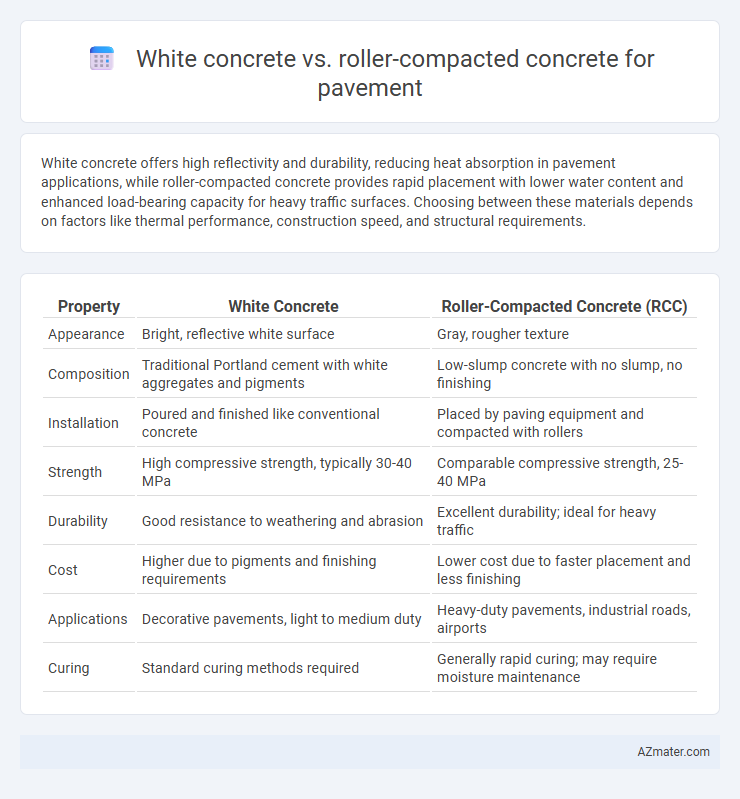White concrete offers high reflectivity and durability, reducing heat absorption in pavement applications, while roller-compacted concrete provides rapid placement with lower water content and enhanced load-bearing capacity for heavy traffic surfaces. Choosing between these materials depends on factors like thermal performance, construction speed, and structural requirements.
Table of Comparison
| Property | White Concrete | Roller-Compacted Concrete (RCC) |
|---|---|---|
| Appearance | Bright, reflective white surface | Gray, rougher texture |
| Composition | Traditional Portland cement with white aggregates and pigments | Low-slump concrete with no slump, no finishing |
| Installation | Poured and finished like conventional concrete | Placed by paving equipment and compacted with rollers |
| Strength | High compressive strength, typically 30-40 MPa | Comparable compressive strength, 25-40 MPa |
| Durability | Good resistance to weathering and abrasion | Excellent durability; ideal for heavy traffic |
| Cost | Higher due to pigments and finishing requirements | Lower cost due to faster placement and less finishing |
| Applications | Decorative pavements, light to medium duty | Heavy-duty pavements, industrial roads, airports |
| Curing | Standard curing methods required | Generally rapid curing; may require moisture maintenance |
Introduction to Pavement Material Options
White concrete offers high reflectivity and durability, making it ideal for reducing heat island effects in urban pavement applications. Roller-compacted concrete (RCC) provides rapid construction and high compressive strength, suited for heavy-duty pavements like industrial yards and highways. Both materials present distinct advantages in terms of cost, strength, and environmental impact, critical factors in pavement material selection.
What is White Concrete?
White concrete is a type of concrete distinguished by the use of white Portland cement, which gives it a bright, reflective surface ideal for reducing urban heat island effects in pavement applications. It offers enhanced durability and aesthetic appeal compared to gray concrete, making it suitable for walkways, streets, and airport runways requiring visibility and heat reduction. Roller-compacted concrete, by contrast, is a no-slump concrete laid with heavy rollers, emphasizing rapid construction and strength rather than surface color or reflectivity.
Overview of Roller-Compacted Concrete (RCC)
Roller-compacted concrete (RCC) is a dense, no-slump concrete mixture designed for rapid placement and compaction using heavy machinery, making it ideal for pavement applications requiring high strength and durability. Its construction method involves layering and compacting the concrete with vibratory rollers, resulting in a cost-effective and time-efficient alternative to traditional white concrete pavements. RCC pavements exhibit excellent load-bearing capacity and resistance to cracking, making them suitable for high-traffic roadways, industrial yards, and airport runways.
Composition Differences between White Concrete and RCC
White concrete for pavement primarily consists of Portland cement, fine and coarse aggregates, white pigment, and water, designed to achieve high reflectivity and aesthetic appeal. Roller-compacted concrete (RCC) incorporates a drier mix with lower water content, using conventional Portland cement, aggregates, and minimal admixtures to enable compaction by heavy rollers without traditional formwork. The key composition difference lies in white concrete's emphasis on whiteness and surface finish, whereas RCC focuses on a stiffer, zero-slump mix optimized for rapid placement and structural strength.
Aesthetic and Visual Considerations
White concrete offers a bright, reflective surface that enhances pavement aesthetics by reducing glare and heat absorption, making it ideal for urban and pedestrian areas. Roller-compacted concrete (RCC) has a more textured, matte finish that provides durability but less visual appeal compared to white concrete. The choice between white concrete and RCC for pavement depends on the balance between desired aesthetic impact and functional requirements.
Structural Performance and Durability
White concrete exhibits superior reflectivity, reducing heat absorption and mitigating thermal cracking, which enhances its structural performance and longevity in pavement applications. Roller-compacted concrete (RCC) offers high compressive strength and rapid construction benefits due to its dense, low-slump mix, providing excellent durability under heavy traffic loads. Both materials demonstrate strong resistance to freeze-thaw cycles and abrasion, but white concrete's thermal stability often results in lower maintenance costs over time compared to RCC.
Installation Methods and Speed
White concrete pavement installation involves traditional batching, mixing, and placing methods requiring skilled labor, with curing times typically extending for several days to achieve optimal strength and durability. Roller-compacted concrete (RCC) uses a drier mix placed and compacted by heavy rollers, enabling faster installation with immediate use in many cases due to rapid setting properties. The RCC method reduces construction time and equipment costs, making it a preferred choice for large-scale pavement projects demanding swift completion.
Cost Comparison: Materials and Labor
White concrete typically incurs higher material costs due to the use of white cement and reflective aggregates, but it offers long-term savings by reducing heat absorption and improving durability. Roller-compacted concrete (RCC) features lower material expenses and faster installation times, leading to significant labor cost reductions for pavement projects. The overall cost efficiency of RCC makes it a preferred choice for large-scale pavements, while white concrete is favored for urban areas seeking aesthetic appeal and thermal comfort.
Environmental Impact and Sustainability
White concrete pavement provides high solar reflectance, significantly reducing the urban heat island effect and lowering cooling energy demands. Roller-compacted concrete (RCC) uses less cement and requires minimal water, resulting in a smaller carbon footprint and faster construction times. Both materials offer sustainable options, but white concrete excels in mitigating heat buildup, while RCC emphasizes resource efficiency and rapid deployment.
Choosing the Right Concrete for Your Pavement Project
White concrete offers a reflective surface that reduces heat absorption, making it ideal for urban environments where heat island effects are a concern, while roller-compacted concrete (RCC) provides a dense, durable pavement suitable for heavy traffic and rapid construction. White concrete typically requires higher material costs and precise finishing, whereas RCC uses a stiffer mix with lower water content for faster placement and reduced labor. Selecting the right concrete depends on project-specific factors such as traffic load, environmental conditions, budget constraints, and desired maintenance levels.

Infographic: White concrete vs Roller-compacted concrete for Pavement
 azmater.com
azmater.com